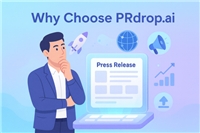Crafting a Compelling Press Release for a Product Release
Launching a new product in the electronics industry? Whether it’s a new sensor, board, chip, or power module, your announcement deserves more than a spec sheet. A well-crafted press release can create buzz, attract media attention, and educate the right audience — if done right.
But far too often, product press releases fall flat. They’re either too technical for media or too vague for engineers. At PRdrop.ai, we help electronics companies find the right balance.
Here’s how to craft a compelling product press release that actually gets noticed — and picked up.
1. Start Strong with a Clear Headline
Your headline is the first thing journalists, editors, and readers see. Make it clear, concise, and benefit-driven.
Avoid this:
“XYZ Corp. Releases New Version of Power Module”
Use this instead:
“XYZ Corp. Launches Compact 20W DC-DC Converter with 95% Efficiency for Industrial IoT Devices”
Your goal is to communicate the value of the product right away — not just that it exists.
2. Nail the First Paragraph
Your opening paragraph should cover the “what, who, when, and why it matters” — in 3 to 4 lines.
Example:
XYZ Corp. today announced the release of its new 20W DC-DC converter, designed to meet the growing power efficiency needs of industrial IoT deployments. With a compact footprint and up to 95% efficiency, the module is aimed at engineers building next-gen embedded systems.
This sets the context and makes it clear why the release is worth reading.
3. Highlight Technical Features — and Explain Why They Matter
Your audience may include journalists, engineers, and purchasing managers. You need to give just enough detail to satisfy all three.
- List 3–5 key features or specifications
- Translate each feature into a benefit or use case
- Use bullet points for clarity
Example:
Key Features:
- Up to 95% energy efficiency → reduces thermal load in enclosed systems
- Compact 18x15mm form factor → ideal for space-constrained applications
- Wide input voltage range (9V–36V) → supports a variety of industrial use cases
- Integrated thermal protection → ensures reliability in harsh environments
4. Include High-Quality Product Images
Don’t leave your product’s first impression to chance. Many companies skip this step — and as a result, media outlets end up using irrelevant or generic visuals.
Include:
- A high-resolution product image (ideally with a white or transparent background)
- An optional secondary image showing real-world usage or product placement
Images increase click-through rates, social shares, and pickup by media outlets. They're also more likely to be featured on websites, blogs, and newsletters.
5. Include a Strong Quote from a Credible Voice
Adding a quote humanizes your announcement and can provide useful insight into your company’s strategic thinking.
Example:
“With growing demand for power efficiency in edge computing, we designed this module to meet both size and performance requirements,” said Jane Lee, Product Manager at XYZ Corp.
Stick to meaningful, non-generic statements that provide context or explain purpose.
6. Don’t Forget SEO and Backlinks
When media outlets republish your press release, they often retain embedded links — which can help with long-term SEO and discovery.
Best practices:
- Link to the product page using relevant anchor text
- Add one internal link to another relevant product or company announcement
- Avoid overloading with links — 2 to 3 is plenty
Think of your press release as part of your broader digital strategy, not just a one-off announcement.
7. Provide Availability and Access Details
Be crystal clear about how someone can get the product — and what stage it’s in.
- Is it available now or is it in pre-order?
- Can engineers request samples?
- Is it available through distributors or only direct?
Example:
The module is now available via authorized distributors and direct order from XYZ Corp. Sample requests and datasheets are available on the product page.
8. Include a Media Kit (Optional but Recommended)
Make life easier for journalists, bloggers, and reviewers by bundling everything into a downloadable media kit.
What to include:
- Press release (PDF or Word)
- Product images (high and web-res)
- Datasheet or brochure
- Company overview (brief)
- Contact for follow-up (if needed)
Hosting this in a zip file or cloud folder and linking to it can increase media adoption.
9. Timing Matters More Than You Think
Releases that go out at the right time perform better — both in terms of visibility and media pickup.
- Avoid Fridays and weekends
- Aim for mid-morning (in the time zone of your target audience)
- If aligning with a product launch, give editors embargoed access in advance
- Consider big electronics events or trade shows — plan around them strategically
10. End with a Clear CTA and Company Boilerplate
Wrap things up with:
- A clear call to action (buy, request a sample, learn more)
- A 2–3 sentence boilerplate about your company
Example CTA:
To learn more or request a sample, visit the XYZ-20W Product Page.
Boilerplate Example:
XYZ Corp. is a leading provider of embedded power solutions for industrial and IoT applications. With over 15 years of experience, XYZ delivers compact, efficient products trusted by engineers worldwide.
Final Thoughts
A product release is more than a technical milestone — it’s a chance to generate awareness, attract media coverage, and engage your target audience. When your press release is crafted thoughtfully and distributed through the right channels, it becomes a growth tool — not just an announcement.
At PRdrop.ai, we’ve made it simple for electronics brands to submit, enhance, and distribute their product news to relevant industry publications. Fast, focused, and built for technical teams.
Launching something soon?
Make your press release count — and get it in front of the right people.


